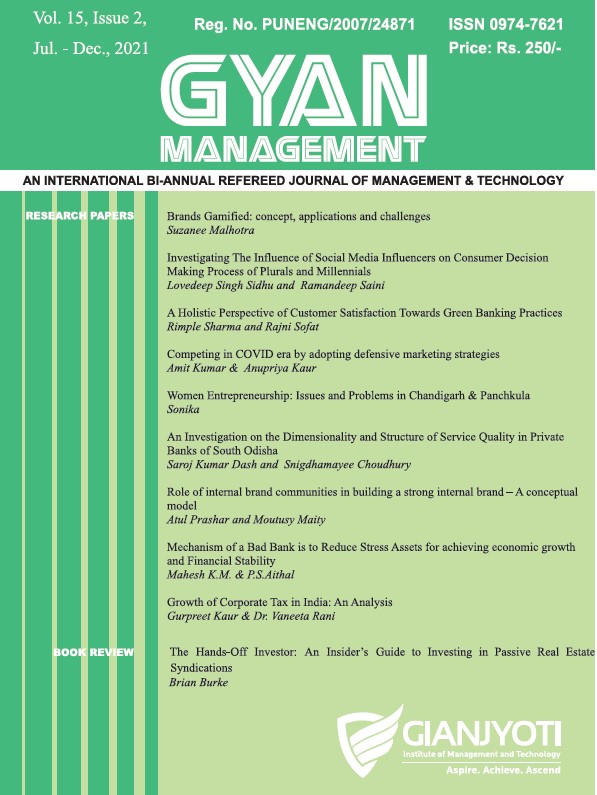Systemic risk and Efficiency analysis of the banking sector: A comparative study of Indian Public and Private Banks
DOI:
https://doi.org/10.48165/gmj.2023.conf5Keywords:
Systemic risk, Efficiency, Banking Sector, Contagious, GFCAbstract
The academics, policymakers and regulators have shown significant curiosity in the study of systemic risk. Intra-country systemic risk has been studied in context of developed economies, but in the context of developing economies it seems to be rare. This research paper’s objective is to present an innovative presentation of the complex interplay between efficiency and systemic risk in Indian banking sector- public and private banks. Due to disagreement among the scholars regarding the relationship between these two factors, we tried to investigate this issue by collecting data from banks listed on the Nifty PSU Bank Index and Nifty Private Bank Index over the period from 2003-04 to 2018-19. The fundamental connection between efficiency and systemic risk has been checked threw granger causality. The results indicate that efficiency and systemic risk are significantly and negatively related, and the relationship is bi-directional for private banks and uni-directional for public banks. Both scholars and regulators could benefit from this article findings.
Downloads
References
Acharya, V., Engle, R., & Richardson, M. (2012). Capital shortfall: A new approach to ranking and regulating systemic risks. American Economic Review, 102(3), 59–64. https://doi.org/10.1257/aer.102.3.59.
Alber, N. (2017). Banking Efficiency and Financial Stability: Which Causes Which? A Panel Analysis. Springer Proceedings in Business and Economics, 91–98. https:// doi.org/10.1007/978-3-319-48454-9_7.
Avkiran, N. K. (2018). Systemic Risk and Productivity of the Major Australian Banks. Theoretical Economics Letters, 08(11), 2157–2168. https://doi.org/10.4236/ tel.2018.811141.
Bach, W., & Nguyen, T. (2012). On the Systemic Relevance of the Insurance Industry: Is a Macroprudential Insurance Regulation Necessary?. Journal of Applied Finance & Banking, 2(1), 127-149. https://www.sci
enpress.com/Upload/JAFB/Vol%202_1_6.pdf. Beccalli, E., Casu, B., & Girardone, C. (2006). Efficiency and Stock Performance in European Banking. Journal of Business Finance & Accounting, 33(1- 2), 245-262. https://onlinelibrary.wiley.com/doi/ abs/10.1111/j.1468-5957.2006.01362.x.
Ben S. Bernanke. (2009). Financial Reform to Address Systemic Risk. At the Council on Foreign Relations, Washington, D.C.
Ben Zeineb, G., & Mensi, S. (2018). Corporate governance, risk and efficiency: evidence from GCC Islamic
banks. Managerial Finance, 44(5), 551–569. https:// doi.org/10.1108/MF-05-2017-0186.
Brownlees, C., Engle, R., Mae, F., Mac, F., Stanley, M., & Stearns, B. (2012). SRISK: A Conditional Capital Shortfall Measure of Systemic Risk. The Review of Financial Studies, 30(1), 48-79. http://vlab.stern.
nyu.edu/.
Das, A., & Kumbhakar, S. C. (2016). Markup and effi ciency of Indian banks: an input distance function approach. Empirical Economics, 51(4), 1689–1719. https://doi.org/10.1007/s00181-015-1062-4.
De Nicolò, G., Favara, G., Ratnovski, L., & Ratnovski, L. (2012). Externalities and Macroprudential Policy. IMF Staff Discussion Note, 12 (5). https://www.imf. org/external/pubs/ft/sdn/2012/sdn1205.pdf.
Ding, D. (2018). Essays on Financial Markets: Bank Efficiency, Risk Taking and Contagion. [Doctoral dis sertation, Rice University]. ProQuest. https://hdl. handle.net/1911/105846.
Ellis, S. (2019). The Role of Systemic Risk, Regulation and Efficiency within the Banking Competition and Financial Stability Relationship. [Doctoral disserta tion, Northumbria University]. ProQuest. https:// nrl.northumbria.ac.uk/id/eprint/39775.
Fiordelisi, F., & Mare, D. S. (2013). Probability of default and efficiency in cooperative banking. Journal of International Financial Markets, Institutions and Money, 26(1), 30–45. https://doi.org/10.1016/j.
intfin.2013.03.003.
Fiordelisi, F., Marques-Ibanez, D., & Molyneux, P. (2010). Efficiency and risk in European banking. Journal of Banking & Finance, 35(5), 1315-1326. https:// www.sciencedirect.com/science/article/abs/pii/ S0378426610003869.
Jeitschko, T. D., & Jeung, S. D. (2005). Incentives for risk-taking in banking – A unified approach. Journal of Banking & Finance, 29(3), 759–777. https://doi. org/10.1016/j.jbankfin.2004.05.028.
Le, M., Smith, D., & Liao, Y. (2018). Three Essays On Bank Risk. [Doctoral dissertation, Queensland University of Technology]. https://eprints.qut.edu.au/120677/.
Levine, R. (2005). Finance and Growth: Theory and Evidence. Handbook of Economic Growth. 1(A), 865–934). https://doi.org/10.1016/S1574- 0684(05)01012-9.
Minsky, H. P., Arestis, P., Sawyer, M., Elgar, E., & Aldershot. (1992). The Financial Instability Hypothesis.
Economics as a social science: Readings in political economy. 201-209. http://www.levyinstitute.org. Minsky, H. P., & Kaufman, H. (2008). Stabilizing an unsta ble economy. New York: McGraw-Hill http://digamo. free.fr/minsky86.pdf.
Podpiera, A., & Podpiera, J. (2006). Deteriorating cost efficiency in commercial banks signals an increasing risk of failure. Czech National Bank. 28. https://www. researchgate.net/publication/4825627.
Reinhart, C. M., & Rogoff, K. S. (2009). The aftermath of financial crises. American Economic Review, 99(2), 466–472. https://doi.org/10.1257/aer.99.2.466.
Saeed, M., & Izzeldin, M. (2016). Examining the rela tionship between default risk and efficiency in Islamic and conventional banks. Journal of Economic Behavior and Organization, 132, 127–154. https:// doi.org/10.1016/j.jebo.2014.02.014.
Sarkar, S., Sensarma, R., & Sharma, D. (2019). The rela tionship between risk, capital and efficiency in Indian banking: Does ownership matter? Journal of Financial Economic Policy, 11(2), 218–231. https:// doi.org/10.1108/JFEP-05-2018-0074.
Tan, Y., & Floros, C. (2018). Risk, competition and efficiency in banking: Evidence from China. Global Finance Journal, 35, 223–236. https://doi. org/10.1016/j.gfj.2017.12.001.
Trade Brains. (2022, November 9). Why are PSU Banks performing better than private banks? Will they continue to do better?. Stock Market News. https:// in.investing.com/news/why-are-psu-banks-per forming-better-than-private-banks-will-they-con tinue-to-do-better-3411597#:~:text=There%20 has%20been%20a%20pick,set%20to%20benefit%20 the%20most.
Verma, R., Ahmad, W., Uddin, G. S., & Bekiros, S. (2019). Analysing the systemic risk of Indian banks. Economics Letters, 176, 103–108. https://doi. org/10.1016/j.econlet.2019.01.003.
Zahra, A. (2016). Default Risk and Efficiency Nexus: Evidence from Banking Sector of Pakistan. [Doctoral dissertation, Capital University of Science & Technology, Islamabad]. https://thesis.cust.edu.
pk/UploadedFiles/ANUM%20ZAHRA-%20 MMS143078.pdf.
Downloads
Published
Issue
Section
License
Copyright (c) 2023 Gyan Management Journal

This work is licensed under a Creative Commons Attribution 4.0 International License.



